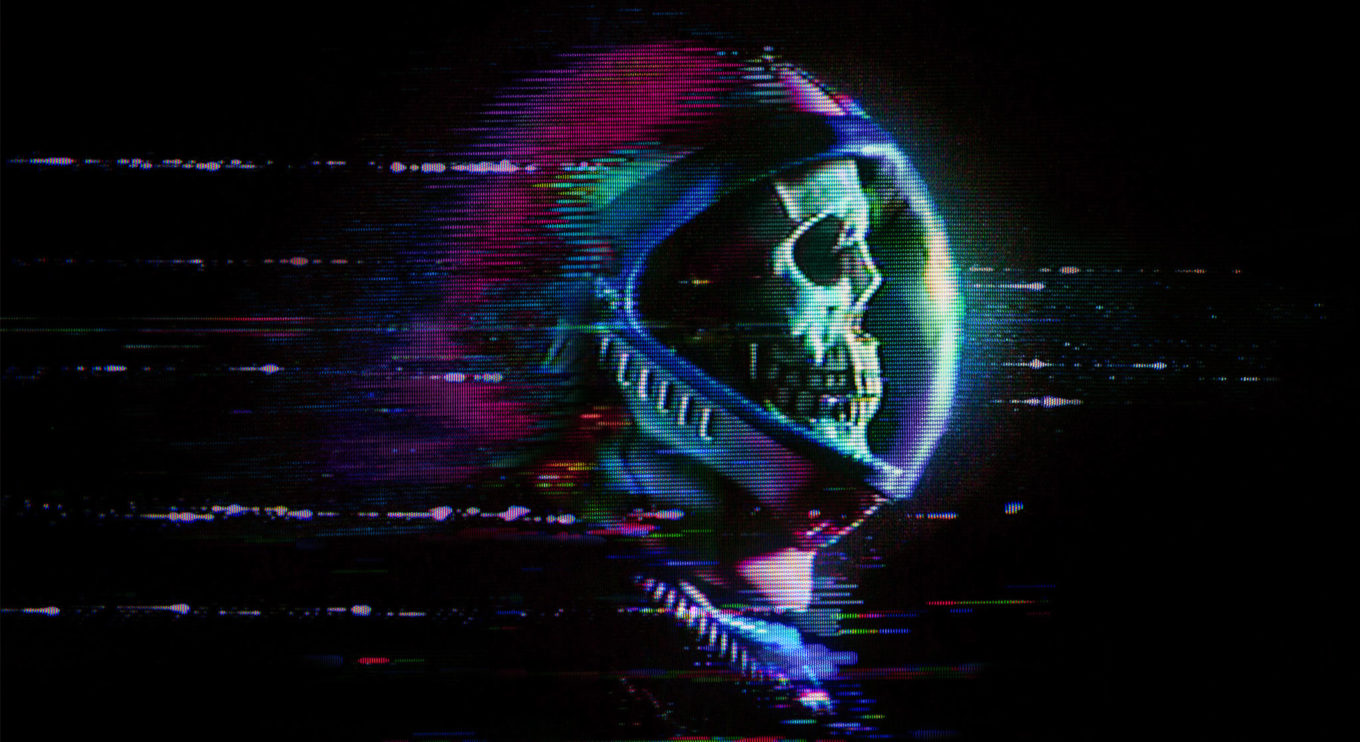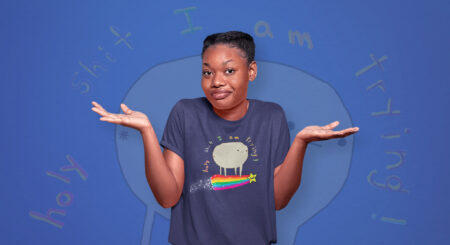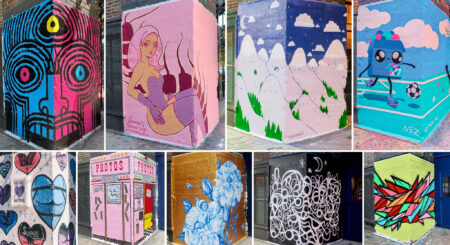With Halloween just around the corner, it’s the perfect time of the year to look at the innovative glitch art of Rob Sheridan, which now appears on Threadless face masks. Sheridan is an art director, graphic designer, writer, and photographer, but many know him best for his groundbreaking work with Nine Inch Nails. In fact, he’s the co-creator of the band’s 2007 alternate-reality game, Year Zero. He also received a Grammy Award nomination for his art direction on the 2008 box set, Ghosts I-IV.
His glitch aesthetic, a kind of “digital grit,” inspired an entire generation of artists in the early 2000s, as he worked closely with Nine Inch Nails frontman Trent Reznor. He collaborated with the group for 15 years, helping create their website, stage productions, media campaigns, music videos, and more. He also went on to become the creative director of Beats Music, which later became Apple Music, and has worked with DC Comics, Sony Music, Universal Music, and HBO.
Sheridan can attribute his success to his unique style of glitch art, which has a special electricity that glows like a fluorescent light in a pitch-black room. His method relies on retro technologies and various media formats to create visual irregularities and imperfections, culminating in notable artworks such as “Glitch Skull Astronaut.”
Next up, Sheridan is preparing the vinyl release of the soundtrack to his graphic novel, High Level. He’s also planning a December drop of holiday-themed designs in his online shop, Glitch Goods by Rob Sheridan. In our recent conversation, he spoke from his home in the Pacific Northwest about happy accidents in art, finding beauty in chaos, and making masks for voters.
Holy cow. What was it like working with Nine Inch Nails and Trent Reznor over the years? I can’t imagine that visualizing their aural aesthetic was easy by any means, especially at the height of their global fame when you came aboard for 1999’s The Fragile.
Rob Sheridan: Working with NIN was an incredible, life-changing journey, especially because I was a huge fan in high school in the ’90s and it was my literal dream job. I began working with them as a teenager helping them build their first website, and my responsibilities kept growing as Trent began to trust my creative ideas more and more, until I was handling all their visuals. Nothing in my career has ever felt as daunting as inventing the artistic aesthetic for a new NIN album. But it really helped being such a big fan who had pored over every detail of their visual aesthetics. It helped me bring my own vision to NIN in a way that remained respectful to what had come before. Truly understanding the specific niche of NIN’s presentation is what made my creative connection with Trent work over the years.
How did NIN help craft your aesthetic and vision as an artist?
I work in a lot of different mediums and aesthetics, but the one I became famous for, “glitch art,” was absolutely crafted by NIN. For 2005’s With Teeth, the first album I art directed end-to-end, I had by then spent hundreds of hours in the studio with Trent and company, observing and absorbing the ways he created and approached sound and music. As someone who isn’t much of a musician, I was taking lessons from how he worked and translating them into visual design.
A lot of what Trent was doing was using tools and instruments the “wrong” way, experimenting with happy accidents, and finding beauty in chaos and noise. I was watching this person who is an incredible musician and a perfectionist pick up instruments or tools he’d never used before and think to himself, “Maybe because I don’t know how to play this, I’ll get some interesting sounds out of it that people who do know how to play it never would (or would reject if they did).”
That philosophy has never left me and I wanted to bring it into my digital artwork. I became inspired by the “flaws” in the limitations of the digital technologies of the time. Compression artifacts, data corruption, pixilation—things like that. I brought those into textural work on With Teeth, which was my digital-glitch-art love letter to Russell Mill’s very organic artwork for The Downward Spiral. While Russell had brought NIN’s music to life in the 1990s grunge language of dirt and flies, I brought it to life a decade later with the new millennium language of damaged computer hardware and corrupted video files. Basically, there’s beauty you can find in doing things the “wrong” way.
The music video for “The Hand That Feeds” became one of the most widely viewed music videos by NIN on YouTube. It also broke ground for its cinematography at the time, which was so different compared to everything else. What do you remember about putting it together?
The concept for “The Hand That Feeds” was inspired by the lo-fi aesthetic of consumer DV cameras, which were new at the time and I had just recently used them to film NIN’s 2001 concert DVD, And All That Could Have Been. Although digital, the video was still recorded onto magnetic tape, and in terms of quality and resolution was, in 2005, far below what any of us can film on our phones today. It created a new world of visual “grit” for the 21st century. Pixel noise, blocky corruption, and interpolation errors were the new dust, hairs, and grain of old film that the 1990s had embraced as the “grunge” aesthetic—perhaps most famously in NIN’s “Closer” video.
For “The Hand That Feeds,” I wanted to continue the digital-glitch aesthetic of With Teeth’s album art by filming a video the “wrong” way. While 24p digital video was the new production darling of the time, I insisted—and I had to fight with the director of photography with a lot of “trust me, I’m doing this on purpose”—on filming in 30i. Zooming into the interlaced video in post-production tore the images apart in interesting ways, disassociating the band members when they moved fast, rebuilding them as they slowed down, and bringing the “digital decay” of the album art into video form. It was a celebration of lo-fi that I never could have imagined would become such an iconic video.
How was the initial Rob Sheridan glitch aesthetic actually born? Was it when you were a student at Pratt Institute? People typically associate the art form with Nam June Paik and, more recently, Cory Arcangel, but what do you add?
My glitch aesthetic has traveled across a lot of styles and mediums over the years, almost all of them born from raw experimentation on consumer hardware. My first true glitch work was with NIN and was inspired by watching Trent work on music. I broke scanners, printers, DV tapes, and other media in search of new textures and moods, thinking of the hardware (and all its flaws) as a collaborator in the process—a collaborator I couldn’t entirely control, which was very freeing. It was later in my glitch-art career that I began experimenting with analog glitch art over digital, taking the same experimental approach but applying it to damaged VHS tapes and old CRT television sets.
That style is something I’ve been working in for a while, and absolutely builds on the work of someone like Nam June Paik. In my case, it was born out of a desire to take the textures that surrounded and inspired my youth—old flickering TV screens, worn-out VCRs, watching sex through scrambled cable, watching violence through static-drenched dubbed VHS tapes—and use them as a paintbrush for dark, psychedelic visions that glow with eerie electro-organic warmth. Flickering CRTs are the yellowed paper of the television age.

What does Halloween mean to you? It seems like a big deal at your home and in your art and life.
A lot of the work I do—from the damaged VHS glitch art to my macabre illustrations—comes from a lifetime of being frightened, challenged, and inspired by horror. Delighting in glimpses of forbidden darkness when I was growing up really came to define me as an artist, and I’ve found a great community with people who enjoy celebrating the beauty and imagination of terror. So naturally, a holiday devoted to horror that also celebrates creativity, art, imagination, and ingenuity is about as perfect as it gets for me. It’s my favorite time of year.
How did you decide on this year’s Halloween face masks? Which one is your favorite?
I had actually been making horror face masks for months before we even considered Halloween specifically. I loved the idea that if we had to wear masks—and please, wear a mask—it didn’t have to be a chore or an inconvenience. It could instead be fun. Half your face is now a canvas to display anything you want, and my thought immediately was, “This is like Halloween every day!” So, I dove into making monster masks right away, and thousands of people were wearing them well before Spooky Season. It really brought out a year-round Halloween spirit for people, and I hope it helped make a public safety issue something to be excited about. I love going to the grocery store as a zombie or an alien or a cyborg. Who wouldn’t?

What made you arrive at your VOTE designs and the masks that say stuff like “Wear a fucking mask, Karen”? Are there people around you who really don’t wear masks?
Early on in the pandemic, when we first started to understand that wearing masks was really important, before there were official mandates, I was relieved to see so many of my neighbors wearing masks at crowded places like grocery stores. But the people who chose not to wear masks began to really stand out to me. It seemed so aggressively rude and uncaring to walk into a crowded shop full of your very worried neighbors and essentially declare, “Your health means nothing to me.” And then, of course, Republicans turned it into a culture war, and lunatics began actively yelling about not wearing a mask, violating local orders on purpose, and exhibiting all kinds of behavior that was just maddening to watch.
You have the vast majority of people making great sacrifices to beat this thing, not only for their own health, but also for the health of their communities. Then you have these assholes who apparently only want to be a part of society when it’s convenient for them. Fuck those people. Absolutely fuck them. Send them to a fucking COVID-ridden island and let them rot if they can’t do the very bare minimum of putting a piece of cloth over their face to protect others. That was the rage that led me to create my “Rage” masks. It was therapy for me, it was reactionary, it was cathartic—and it really resonated with a lot of people who were feeling the same thing.

Lastly, what made you arrive at recreating war posters as t-shirt designs that are apropos for 2020? What sense do you make of this current dystopia in America?
It was unsurprising but still shocking to see the Republican’s pandemic narrative quickly turn to, “You just need to get out there and risk your life, because the economy has to keep moving!” I was shocked at how many people willingly accepted that as the only option, when we have a federal government that could have easily afforded sweeping aid and a national strategy to protect people financially while keeping them home. Suddenly, it was like Republicans were beating the drums of a very one-sided war, and asking people who could barely afford their rent to sacrifice their health in service of the stock markets. And when you think about it as a war, the propaganda language of war comes to mind.
Propaganda works for a reason: It’s a very effective communicator. So, I wanted to turn that on its head and use it to illustrate the absurdity of Republicans asking Americans to make an unnecessary sacrifice. The series resonated with people more than I ever expected. Satire and dark humor have always been such great tools for helping us process dystopian times, and they’ve been a cathartic form of release for writers and artists who want to channel their anger into something productive. I hope, more than anything, that we’re about to turn a corner in this country where I can focus on more hopeful work. But I’m worried. I’m really worried.







